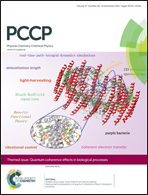Origins of contrasting copper coordination geometries in crystalline copper sulfate pentahydrate†
Abstract
Metal-aqua ion ([M(H2O)n]X+) formation is a fundamental step in mechanisms that are central to enzymatic and industrial catalysis. Past investigations of such ions have yielded a wealth of information regarding their properties, however questions still exist involving the exact structures of these complexes. A prominent example of this is hexaaqua copper(II) ([Cu(H2O)6]2+), with the solution versus gas-phase configurations under debate. The differences are often attributed to the intermolecular interactions between the bulk solvent and the aquated complex, resulting in structures stabilized by extended hydrogen-bonding networks. Yet solution phase systems are difficult to study due to the lack of atomic-level positional details. Crystalline solids are ideal models for comparative study, as they contain fixed structures that can be fully characterized using diffraction techniques. Here, crystalline copper sulfate pentahydrate (CuSO4·5H2O), which contains two unique copper–water geometries, was studied in order to elucidate the origin of these contrasting hydrated metal envrionments. A combination of solid-state density functional theory and low-temperature X-ray diffraction was used to probe the electronic origins of this phenomenon. This was accomplished through implementation of crystal orbital overlap population and crystal orbital Hamiltonian population analyses into a developmental version of the CRYSTAL14 software. These new computational methods help highlight the delicate interplay between electronic structure and metal–water geometries.


 Please wait while we load your content...
Please wait while we load your content...